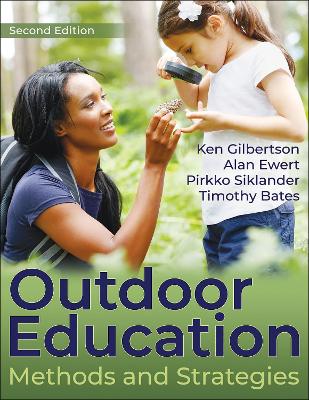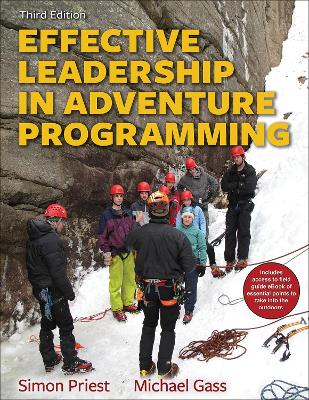Outdoor Education
 -15%
portes grátis
-15%
portes grátis
Outdoor Education
Methods and Strategies
Bates, Timothy; Siklander, Pirkko; Gilbertson, Ken; Ewert, Alan
Human Kinetics Publishers
04/2022
280
Mole
Inglês
9781492591221
15 a 20 dias
794
Descrição não disponível.
Part I. Foundations of Outdoor Education
Chapter 1. Defining Outdoor Education
Why the Outdoors?
Model of Outdoor Education
Environmental Education
Interpretation
Adventure Education
Experiential Education
Education Structure
Development of Outdoor Education
Rationale for Teaching Outdoors
Summary
Chapter 2. Describing the Outdoor Educator
Professionalism
Professional Responsibilities
Summary
Chapter 3. Learning Theories in Outdoor Education
Theories in Outdoor Education
Learning Theory Guiding Outdoor Education
Experiential Education
Constructivism
Scaffolding
Brain-Based Learning
Environmental Learning
Multiple Intelligences
Playful Learning Theory
Summary
Part II. Preparation for Teaching Outdoors
Chapter 4. Understanding Participants
Audience Assessment
Stereotyping
Gender
Age and Cognitive Development
Medical Conditions
Experience
Group Familiarity
Abilities
Culture and Ethnicity
Strategies for Teaching Diverse Audiences
Summary
Chapter 5. Creating the Learning Environment
Foundations of the Learning Environment
Components of Successful Learning Environments
Summary
Chapter 6. Outdoor Education Settings
Site Selection
Learning Barriers
Equipment
Logistics
Record Keeping
Special Settings: Lessons in the Night
Summary
Chapter 7. Designing Lessons
Advantages of Lesson Plans
Format
Structure
Assessment
Summary
Part III. Methods and Delivery of Outdoor Education
Chapter 8. Physical Methods
Physical Skills Development
Physical Manipulation
Activities, Games, and Competitions
Theatrics
Initiatives and Ropes Courses
Summary
Chapter 9. Cognitive Methods
Lecture and Discussion
Inquiry
Videography
Service Learning
Supporting Materials
Peer Teaching
Summary
Chapter 10. Affective Methods
Guided Discovery
Visual Imagery
Storytelling
Scenarios and Case Studies
Summary
Chapter 11. Sample Lessons
Night Hike
Navigation
Maple Sugar Bush
Weather
Fishing Ethics
Basic Techniques for Sea Kayaking
Personal Growth
Lighting a Camp Stove
Nature Awareness
Summary
Chapter 12. Your Future in Outdoor Education
Issues and Trends Affecting Outdoor Education
Working With Mainstream Education
State Standards and High-Stakes Testing
Professional Certification
Education or Advocacy?
Emotional Needs of Participants
Strategic Planning for Professional Growth
Summary
Appendix A. Professional Organizations in the United States and Internationally
Appendix B. Sample Forms
Chapter 1. Defining Outdoor Education
Why the Outdoors?
Model of Outdoor Education
Environmental Education
Interpretation
Adventure Education
Experiential Education
Education Structure
Development of Outdoor Education
Rationale for Teaching Outdoors
Summary
Chapter 2. Describing the Outdoor Educator
Professionalism
Professional Responsibilities
Summary
Chapter 3. Learning Theories in Outdoor Education
Theories in Outdoor Education
Learning Theory Guiding Outdoor Education
Experiential Education
Constructivism
Scaffolding
Brain-Based Learning
Environmental Learning
Multiple Intelligences
Playful Learning Theory
Summary
Part II. Preparation for Teaching Outdoors
Chapter 4. Understanding Participants
Audience Assessment
Stereotyping
Gender
Age and Cognitive Development
Medical Conditions
Experience
Group Familiarity
Abilities
Culture and Ethnicity
Strategies for Teaching Diverse Audiences
Summary
Chapter 5. Creating the Learning Environment
Foundations of the Learning Environment
Components of Successful Learning Environments
Summary
Chapter 6. Outdoor Education Settings
Site Selection
Learning Barriers
Equipment
Logistics
Record Keeping
Special Settings: Lessons in the Night
Summary
Chapter 7. Designing Lessons
Advantages of Lesson Plans
Format
Structure
Assessment
Summary
Part III. Methods and Delivery of Outdoor Education
Chapter 8. Physical Methods
Physical Skills Development
Physical Manipulation
Activities, Games, and Competitions
Theatrics
Initiatives and Ropes Courses
Summary
Chapter 9. Cognitive Methods
Lecture and Discussion
Inquiry
Videography
Service Learning
Supporting Materials
Peer Teaching
Summary
Chapter 10. Affective Methods
Guided Discovery
Visual Imagery
Storytelling
Scenarios and Case Studies
Summary
Chapter 11. Sample Lessons
Night Hike
Navigation
Maple Sugar Bush
Weather
Fishing Ethics
Basic Techniques for Sea Kayaking
Personal Growth
Lighting a Camp Stove
Nature Awareness
Summary
Chapter 12. Your Future in Outdoor Education
Issues and Trends Affecting Outdoor Education
Working With Mainstream Education
State Standards and High-Stakes Testing
Professional Certification
Education or Advocacy?
Emotional Needs of Participants
Strategic Planning for Professional Growth
Summary
Appendix A. Professional Organizations in the United States and Internationally
Appendix B. Sample Forms
Este título pertence ao(s) assunto(s) indicados(s). Para ver outros títulos clique no assunto desejado.
Outdoor education; methods; theories; lecture; experiential learning; teaching; lesson plans; adventure; activities; games; service learning; peer teaching; physical skills; constructivism; environment; student assessment; site selection; equipment
Part I. Foundations of Outdoor Education
Chapter 1. Defining Outdoor Education
Why the Outdoors?
Model of Outdoor Education
Environmental Education
Interpretation
Adventure Education
Experiential Education
Education Structure
Development of Outdoor Education
Rationale for Teaching Outdoors
Summary
Chapter 2. Describing the Outdoor Educator
Professionalism
Professional Responsibilities
Summary
Chapter 3. Learning Theories in Outdoor Education
Theories in Outdoor Education
Learning Theory Guiding Outdoor Education
Experiential Education
Constructivism
Scaffolding
Brain-Based Learning
Environmental Learning
Multiple Intelligences
Playful Learning Theory
Summary
Part II. Preparation for Teaching Outdoors
Chapter 4. Understanding Participants
Audience Assessment
Stereotyping
Gender
Age and Cognitive Development
Medical Conditions
Experience
Group Familiarity
Abilities
Culture and Ethnicity
Strategies for Teaching Diverse Audiences
Summary
Chapter 5. Creating the Learning Environment
Foundations of the Learning Environment
Components of Successful Learning Environments
Summary
Chapter 6. Outdoor Education Settings
Site Selection
Learning Barriers
Equipment
Logistics
Record Keeping
Special Settings: Lessons in the Night
Summary
Chapter 7. Designing Lessons
Advantages of Lesson Plans
Format
Structure
Assessment
Summary
Part III. Methods and Delivery of Outdoor Education
Chapter 8. Physical Methods
Physical Skills Development
Physical Manipulation
Activities, Games, and Competitions
Theatrics
Initiatives and Ropes Courses
Summary
Chapter 9. Cognitive Methods
Lecture and Discussion
Inquiry
Videography
Service Learning
Supporting Materials
Peer Teaching
Summary
Chapter 10. Affective Methods
Guided Discovery
Visual Imagery
Storytelling
Scenarios and Case Studies
Summary
Chapter 11. Sample Lessons
Night Hike
Navigation
Maple Sugar Bush
Weather
Fishing Ethics
Basic Techniques for Sea Kayaking
Personal Growth
Lighting a Camp Stove
Nature Awareness
Summary
Chapter 12. Your Future in Outdoor Education
Issues and Trends Affecting Outdoor Education
Working With Mainstream Education
State Standards and High-Stakes Testing
Professional Certification
Education or Advocacy?
Emotional Needs of Participants
Strategic Planning for Professional Growth
Summary
Appendix A. Professional Organizations in the United States and Internationally
Appendix B. Sample Forms
Chapter 1. Defining Outdoor Education
Why the Outdoors?
Model of Outdoor Education
Environmental Education
Interpretation
Adventure Education
Experiential Education
Education Structure
Development of Outdoor Education
Rationale for Teaching Outdoors
Summary
Chapter 2. Describing the Outdoor Educator
Professionalism
Professional Responsibilities
Summary
Chapter 3. Learning Theories in Outdoor Education
Theories in Outdoor Education
Learning Theory Guiding Outdoor Education
Experiential Education
Constructivism
Scaffolding
Brain-Based Learning
Environmental Learning
Multiple Intelligences
Playful Learning Theory
Summary
Part II. Preparation for Teaching Outdoors
Chapter 4. Understanding Participants
Audience Assessment
Stereotyping
Gender
Age and Cognitive Development
Medical Conditions
Experience
Group Familiarity
Abilities
Culture and Ethnicity
Strategies for Teaching Diverse Audiences
Summary
Chapter 5. Creating the Learning Environment
Foundations of the Learning Environment
Components of Successful Learning Environments
Summary
Chapter 6. Outdoor Education Settings
Site Selection
Learning Barriers
Equipment
Logistics
Record Keeping
Special Settings: Lessons in the Night
Summary
Chapter 7. Designing Lessons
Advantages of Lesson Plans
Format
Structure
Assessment
Summary
Part III. Methods and Delivery of Outdoor Education
Chapter 8. Physical Methods
Physical Skills Development
Physical Manipulation
Activities, Games, and Competitions
Theatrics
Initiatives and Ropes Courses
Summary
Chapter 9. Cognitive Methods
Lecture and Discussion
Inquiry
Videography
Service Learning
Supporting Materials
Peer Teaching
Summary
Chapter 10. Affective Methods
Guided Discovery
Visual Imagery
Storytelling
Scenarios and Case Studies
Summary
Chapter 11. Sample Lessons
Night Hike
Navigation
Maple Sugar Bush
Weather
Fishing Ethics
Basic Techniques for Sea Kayaking
Personal Growth
Lighting a Camp Stove
Nature Awareness
Summary
Chapter 12. Your Future in Outdoor Education
Issues and Trends Affecting Outdoor Education
Working With Mainstream Education
State Standards and High-Stakes Testing
Professional Certification
Education or Advocacy?
Emotional Needs of Participants
Strategic Planning for Professional Growth
Summary
Appendix A. Professional Organizations in the United States and Internationally
Appendix B. Sample Forms
Este título pertence ao(s) assunto(s) indicados(s). Para ver outros títulos clique no assunto desejado.




